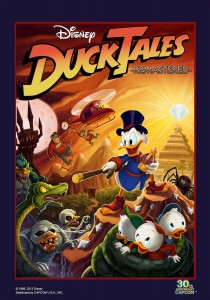 BUY IT FROM AMAZON: RIGHT HERE! (Steam Code)
BUY IT FROM AMAZON: RIGHT HERE! (Steam Code)
PLATFORM: XBox Live Arcade (reviewed, releasing Sept 11), Playstation Network, Nintendo eShop, PC (Steam)
PRICE: $14.99
ESRB RATING: E
DEVELOPER: Wayforward
PUBLISHER: Capcom
Trying to bring back a beloved game from the depths of retro oblivion is a thankless task. There will be those who, having been weaned from the trial by fire that is 8-bit game design, will see a game sticking too close to the roots as a stubborn refusal to evolve with modern sensibilities, and will toss a controller within 15 minutes. There will be those who never had an attachment to the original game to begin with who will ignore it entirely. There will be those who will have themselves a jolly jumpin’ joygasm over the game, and they haven’t even gotten past the title screen yet.
So, I’ll let those of you with things to do today decide now whether to duck out* of what’s going to be a fairly positive review of Ducktales Remastered. I was born in 1982, meaning I was the prime age for both NES games, and for Ducktales. I was raised on a diet of hard-as-coffin-nails 2D platformers. I’m the guy that spent entire summers bashing my head against a brick wall trying to beat Blaster Master and Battletoads, and the first Ninja Turtles game, and succeeded on all three. I failed at Ghosts N’ Goblins. I’ve seen the original cartoon within the last 3 years or so, and it still miraculously stands the test of time, though I’m obviously not its target audience anymore. I’ve played the original NES version of this game within the last year, and ended up taking my ball and going home when I was sent back to Transylvania for the THIRD time on zero lives left to find Dracula Duck.
So, with all that factored in, you can sprinkle as much salt on the statement as you choose, when I say that the game is “pretty good”.
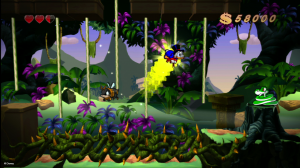 The spirit behind Wayforward’s title is the best kind of retro approach, one that feels like the natural extrapolation of ideas from the original game, unfettered by budget and hardware. 8-bit pixels are now beautiful, Disney-perfect renditions of the original cartoon’s art style, mixed with 2.5d backgrounds. What was once plain rocky backdrop, and gray windows and coffins is now lush, Mayan temples and stormy, haunted landscape. The soundtrack, with respectful weaving of the chiptune past, has wildly imaginative and varied instrumentation, and yes, game music nerds, the remixed Moon theme is solid gold. The bosses still follow set patterns, but with added curveballs, such as Magica DeSpell taking more than a minor cue from Castlevania‘s Dracula fights, or the snow beast from the Himalayas taking up half a screen.
The spirit behind Wayforward’s title is the best kind of retro approach, one that feels like the natural extrapolation of ideas from the original game, unfettered by budget and hardware. 8-bit pixels are now beautiful, Disney-perfect renditions of the original cartoon’s art style, mixed with 2.5d backgrounds. What was once plain rocky backdrop, and gray windows and coffins is now lush, Mayan temples and stormy, haunted landscape. The soundtrack, with respectful weaving of the chiptune past, has wildly imaginative and varied instrumentation, and yes, game music nerds, the remixed Moon theme is solid gold. The bosses still follow set patterns, but with added curveballs, such as Magica DeSpell taking more than a minor cue from Castlevania‘s Dracula fights, or the snow beast from the Himalayas taking up half a screen.
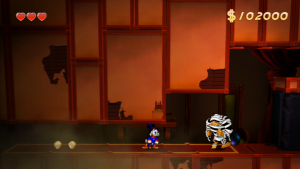 It is not a reinvention of the wheel, and while that means the game many of us grew up with is still under the new flash and flair, it also means the game many of us wanted to punt a small woodland creature into the stratosphere over is in here too. The core gameplay requires instincts long buried in the face of regenerating health and infinite lives. Losing the last life, even on a boss, means starting a level over from scratch. These are the good kinds of frustrating, that requires skill, patience, and twitch memory. Enemies respawn after leaving the screen a second, and attack at angles you have no defense for. A few of the stages have severe Metroidvania backtracking problems. Nothing as bad as the NES game, where Transylvania might as well be the hub world for as many times as you have to go back and replay that thing, but it’s a problem. The pogo stick/cane is still blood-boilingly unreliable, even with a minor change of not having to press down on the pad to activate it. This is NOT the good kind of frustrating, and factoring in that the pogo stick is Scrooge’s primary mode of transport, it occasionally feels like a game killer. What it all comes down to is that this is still a middle-age NES game at its core, and everything that entails. This is a game where the mechanics sometimes have to be wrestled into submission, and mileage may vary on how satisfying it is when you’re able to still pull off miracles with them.
It is not a reinvention of the wheel, and while that means the game many of us grew up with is still under the new flash and flair, it also means the game many of us wanted to punt a small woodland creature into the stratosphere over is in here too. The core gameplay requires instincts long buried in the face of regenerating health and infinite lives. Losing the last life, even on a boss, means starting a level over from scratch. These are the good kinds of frustrating, that requires skill, patience, and twitch memory. Enemies respawn after leaving the screen a second, and attack at angles you have no defense for. A few of the stages have severe Metroidvania backtracking problems. Nothing as bad as the NES game, where Transylvania might as well be the hub world for as many times as you have to go back and replay that thing, but it’s a problem. The pogo stick/cane is still blood-boilingly unreliable, even with a minor change of not having to press down on the pad to activate it. This is NOT the good kind of frustrating, and factoring in that the pogo stick is Scrooge’s primary mode of transport, it occasionally feels like a game killer. What it all comes down to is that this is still a middle-age NES game at its core, and everything that entails. This is a game where the mechanics sometimes have to be wrestled into submission, and mileage may vary on how satisfying it is when you’re able to still pull off miracles with them.
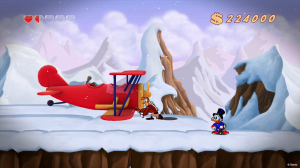 The irony is that the other frustration of the game comes from its greatest current gen enhancement. Whereas the original game was left to 10 second pauses for tips and tricks from the NPCs, Remastered has full blown cutscenes, with the entirety of the original cartoon’s cast providing voices. The amount of TLC that’s gone into these scenes leaves the player with a warm, fuzzy feeling for a while. With some very simple animations and added NPCs, the game creates the feel of playing multiple, disparate episodes of Ducktales at the outset, and there’s some endearing little twists on the stages from the NES game, like Flintheart Glomgold playing more of a role, getting some fun explanations on the bosses, the new, final, dramatic Mt. Vesuvius stage to rescue the nephews instead of Yet Another Trip To Transylvania (with some new, badass, Dr. Wily-style BGM to boot), or Gizmoduck’s cameo being expanded, including a cameo by his mild-mannered alter ego, Fenton Quackbush. Then comes the sinking feeling: These scenes massacre the flow of the game, stopping any possibility of focused gamer zen just so Scrooge can bitch out Launchpad McQuack for the 12th time this level. Again comes the frustration: This is the kind of change we want, but not at the expense of gameplay.
The irony is that the other frustration of the game comes from its greatest current gen enhancement. Whereas the original game was left to 10 second pauses for tips and tricks from the NPCs, Remastered has full blown cutscenes, with the entirety of the original cartoon’s cast providing voices. The amount of TLC that’s gone into these scenes leaves the player with a warm, fuzzy feeling for a while. With some very simple animations and added NPCs, the game creates the feel of playing multiple, disparate episodes of Ducktales at the outset, and there’s some endearing little twists on the stages from the NES game, like Flintheart Glomgold playing more of a role, getting some fun explanations on the bosses, the new, final, dramatic Mt. Vesuvius stage to rescue the nephews instead of Yet Another Trip To Transylvania (with some new, badass, Dr. Wily-style BGM to boot), or Gizmoduck’s cameo being expanded, including a cameo by his mild-mannered alter ego, Fenton Quackbush. Then comes the sinking feeling: These scenes massacre the flow of the game, stopping any possibility of focused gamer zen just so Scrooge can bitch out Launchpad McQuack for the 12th time this level. Again comes the frustration: This is the kind of change we want, but not at the expense of gameplay.
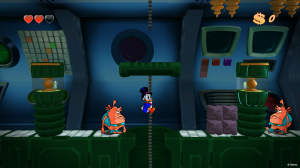 So, if we’re going to be objective about Ducktales Remastered, it’s very much a disjointed, aggravating game whose tweaks miss a few crucial spots there was ample opportunity to fix. And if I had to put a number on it, each of those aggravations lasted for approximately 3.8 seconds. The rest of the time between, it’s endlessly charming, full of heart, respect for its 8-bit roots, blatantly and effectively chumming for nostalgia, and the kind of legitimate challenge we don’t get often enough. The end result is that the folks who were planning on getting this anyway will find their joy justified, with their attachment to this property and this game being catered to with kid gloves. Meanwhile, anyone coming at this blind will find themselves Grumpy Catting through this whole thing, fastballing their controller at 102mph through a flat-screen the second they fall down a bottomless pit five feet from a boss fight, then going back to being molly-coddled by whatever number Ratchet & Clank we’re up to now. And they, too, would be justified, though the game makes no bones about trying to entice a new generation of fans anyway. This is a retro love letter. This is a game that knows its audience, and caters to them with aplomb, at the expense of new-school polish. There’s no shame in avoidance for anyone who didn’t get their rose-colored glasses in the mail. There is, however, pity for anyone who doesn’t at least know why everyone else is smiling.
So, if we’re going to be objective about Ducktales Remastered, it’s very much a disjointed, aggravating game whose tweaks miss a few crucial spots there was ample opportunity to fix. And if I had to put a number on it, each of those aggravations lasted for approximately 3.8 seconds. The rest of the time between, it’s endlessly charming, full of heart, respect for its 8-bit roots, blatantly and effectively chumming for nostalgia, and the kind of legitimate challenge we don’t get often enough. The end result is that the folks who were planning on getting this anyway will find their joy justified, with their attachment to this property and this game being catered to with kid gloves. Meanwhile, anyone coming at this blind will find themselves Grumpy Catting through this whole thing, fastballing their controller at 102mph through a flat-screen the second they fall down a bottomless pit five feet from a boss fight, then going back to being molly-coddled by whatever number Ratchet & Clank we’re up to now. And they, too, would be justified, though the game makes no bones about trying to entice a new generation of fans anyway. This is a retro love letter. This is a game that knows its audience, and caters to them with aplomb, at the expense of new-school polish. There’s no shame in avoidance for anyone who didn’t get their rose-colored glasses in the mail. There is, however, pity for anyone who doesn’t at least know why everyone else is smiling.
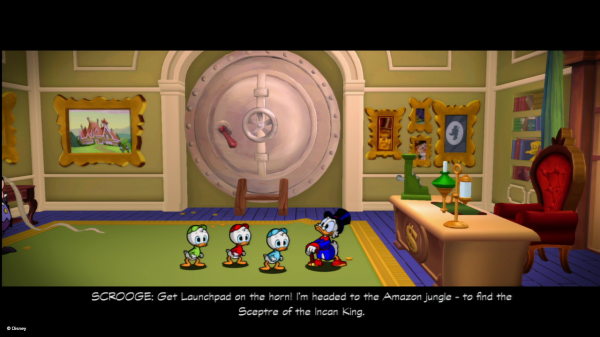
Rating: 




Out of a Possible 5 Stars
*-I swear to sweet, swarthy Christ that pun was unintended.
